All About the 1715 Spanish Plate Fleet
Welcome to the Golden Age of Piracy - As Seen On Discovery Channel's Cooper's Treasure & Travel Channel’s Expedition Unknown
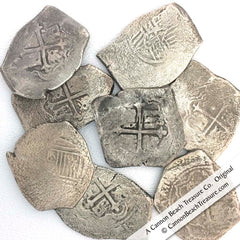 The fabled 1715 Spanish Treasure Fleet has been the subject of two major Hollywood motion pictures and recent television docu-dramas like Netflix's The Lost Pirate Kingdom. The films, The Deep, and Fool’s Gold, and the series Black Sails, portray romanticized versions of the discovery of the vast treasures of the lost Spanish Treasure Fleet. Discovery Channel's Cooper's Treasure and Travel Channel’s Expedition Unknown portray the salvage of the Fleet’s wreck. However, whether Hollywood or TV, what you see is a brief, exciting glimpse into the fascinating story that is the creation, loss and recovery of one of the most legendary lost treasures of all time.
The fabled 1715 Spanish Treasure Fleet has been the subject of two major Hollywood motion pictures and recent television docu-dramas like Netflix's The Lost Pirate Kingdom. The films, The Deep, and Fool’s Gold, and the series Black Sails, portray romanticized versions of the discovery of the vast treasures of the lost Spanish Treasure Fleet. Discovery Channel's Cooper's Treasure and Travel Channel’s Expedition Unknown portray the salvage of the Fleet’s wreck. However, whether Hollywood or TV, what you see is a brief, exciting glimpse into the fascinating story that is the creation, loss and recovery of one of the most legendary lost treasures of all time. Our site features the shining silver “Pieces of Eight” recovered from an ill-fated ship which was part of the 1715 Plate Fleet. (“Plate” comes from the Spanish word plata, which means silver.)
Our site features the shining silver “Pieces of Eight” recovered from an ill-fated ship which was part of the 1715 Plate Fleet. (“Plate” comes from the Spanish word plata, which means silver.) 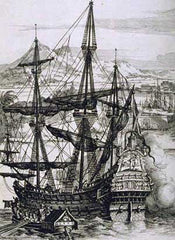
The fleet was fell victim to a hurricane that struck when it was just a few days off port. The ferocity of the hurricane dashed most of the Fleet’s ships on the reefs just south of what is known today as Cape Canaveral, Florida - the northeastern end of the Caribbean.
Image 1: Freshly conserved 1715 Fleet Shipwreck 8 Real "Pieces of Eight"
Image 2: A 1715 Shipwreck 8 Real set in a Sterling silver pendant with Columbian Emerald
Image 3: A Spanish Galleon prepares for the journey.
The Rise of the Spanish Fleet System
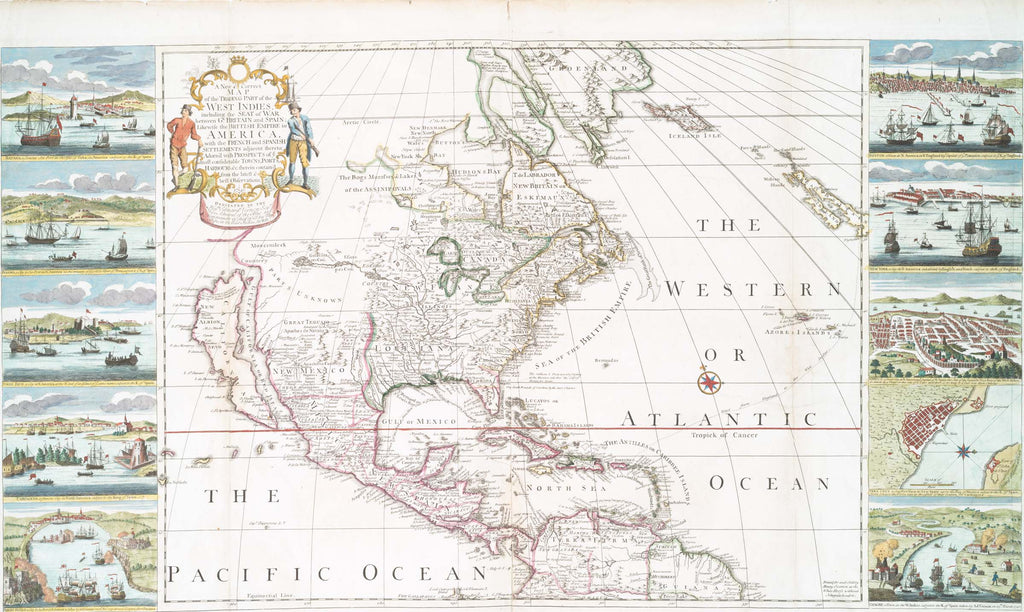
Image 4: This chart, published on December 31, 1740 was: "Dedicated to the Honble. Edward Vernon Esqr., Vice Admiral of the Blue and Commander in chief of all his Majs. ships in the West Indies, by H.O." It Includes insets of the views of: Havana, Panama, Porto Rico, Cartagena, Porto Bello, Boston, New York, Mexico and Vera Cruz.
In the earliest days of Spain’s shipping silver, gold and other commodities back to the Old World, beginning shortly after Christopher Coloumbus’ first landing in the Bahamas in 1492, vessels sailed back to Spain (or attempted to) in small fleets of just a few ships. Galleons loaded with bounties of silver and gold from New World ports such as Veracruz, Cartagena and ports in Panama would gather in Havana Harbor in Cuba, setting sail in small groups for the treacherous voyage back to Spain.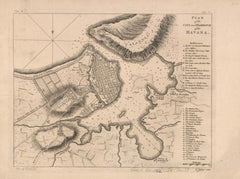 This would leave them vulnerable to attacks from pirates and privateers. However, all this changed after French privateers pillaged Havana in 1555. By the 1560s, the Fleet System was established, calling for larger groups of heavily armed ships to sail on two established sea lanes… one for treasure being shipped back to Spain, and the other in the Pacific for treasure being shipped to Manilla for trade in the Orient.
This would leave them vulnerable to attacks from pirates and privateers. However, all this changed after French privateers pillaged Havana in 1555. By the 1560s, the Fleet System was established, calling for larger groups of heavily armed ships to sail on two established sea lanes… one for treasure being shipped back to Spain, and the other in the Pacific for treasure being shipped to Manilla for trade in the Orient.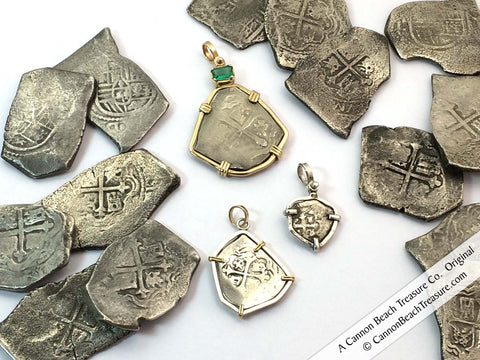 Treasure galleons of the Spanish West Indies Fleets like the 1715 Fleet, loaded with goods of every description, including the all-important treasure, would sail from Veracruz, Cartagena, Portobello and other New World ports to Havana, Cuba to form the Fleet. After the Fleet was formed and prepared for the journey, they sailed through the Straits of Florida, following the Gulf Stream past the Florida Keys. They would continue to sail up Florida until reaching what is now northern Florida before turning east. From there they would sail into the Atlantic headed toward Spain.
Treasure galleons of the Spanish West Indies Fleets like the 1715 Fleet, loaded with goods of every description, including the all-important treasure, would sail from Veracruz, Cartagena, Portobello and other New World ports to Havana, Cuba to form the Fleet. After the Fleet was formed and prepared for the journey, they sailed through the Straits of Florida, following the Gulf Stream past the Florida Keys. They would continue to sail up Florida until reaching what is now northern Florida before turning east. From there they would sail into the Atlantic headed toward Spain.
Image 5: A 1762 illustration of the harbor and surrounding area of Havana, Cuba.
Image 6: 1715 Shipwreck Pieces of Eight and Treasure Coin Pendants.
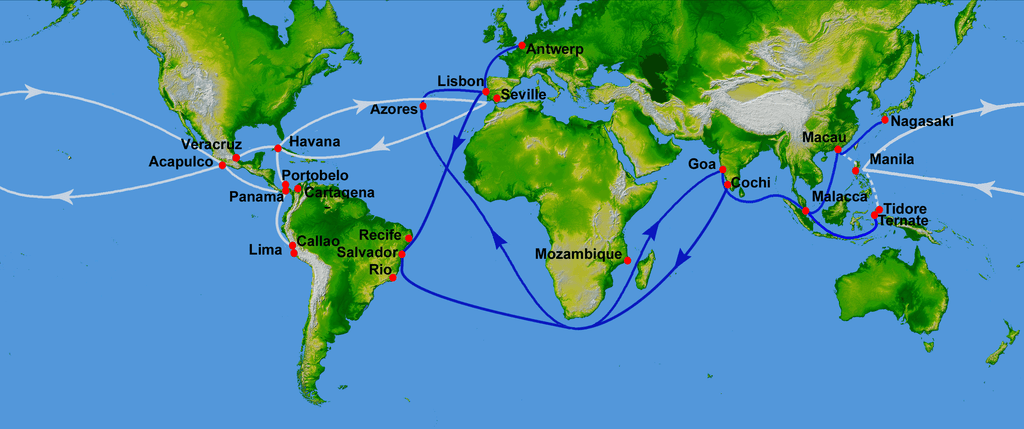
Image 7: An illustration of the Atlantic and Pacific sea routes of the Spanish Treasure Fleets.
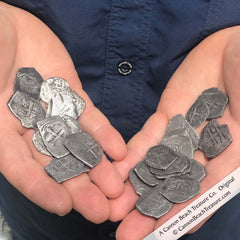 While the Fleets are famous for their cargo of glittering gold, silver and gems, they also carried a wide variety of goods including agricultural products, lower value metals, lumber, luxury goods, spices, sugar, tobacco, pearls, silk, and coveted exotic items from Spanish Empire colonies both in the New World and the far East. However, the most valuable cargo they took with them was the silver, gold and gems that were mined from the New World. Our coins come from the same magnificent stockpile.
While the Fleets are famous for their cargo of glittering gold, silver and gems, they also carried a wide variety of goods including agricultural products, lower value metals, lumber, luxury goods, spices, sugar, tobacco, pearls, silk, and coveted exotic items from Spanish Empire colonies both in the New World and the far East. However, the most valuable cargo they took with them was the silver, gold and gems that were mined from the New World. Our coins come from the same magnificent stockpile.
Setting Sail into History
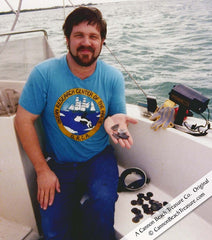 The 1715 Spanish Treasure Fleet set sail after tedious delays had forced it to stay at anchor in Havana well in to hurricane season. And these delays sealed its fate. A few days after leaving Havana, King Philip’s mighty fleet was left battered and broken to pieces… spread for mile after mile along the beaches south of present-day Cape Canaveral.
The 1715 Spanish Treasure Fleet set sail after tedious delays had forced it to stay at anchor in Havana well in to hurricane season. And these delays sealed its fate. A few days after leaving Havana, King Philip’s mighty fleet was left battered and broken to pieces… spread for mile after mile along the beaches south of present-day Cape Canaveral.
Image 8: Rare 4 Reales from the 1715 Fleet - just conserved by Robert Lewis Knecht of Cannon Beach Treasure Company.
Image 9: Robert Lewis Knecht recovered Spanish "Pieces of Eight" from the 1715 Fleet off of Vero Beach, Florida.
The Salvage of the Spanish 1715 Plate Fleet
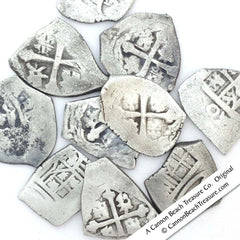 While the Spanish established a salvage camp and recovered vast amounts of treasure, thousands of 1715 Fleet gold and silver coins remained unrecovered, and the fate of the 1715 Fleet passed into memory until…
While the Spanish established a salvage camp and recovered vast amounts of treasure, thousands of 1715 Fleet gold and silver coins remained unrecovered, and the fate of the 1715 Fleet passed into memory until… Nearly two and a half centuries had passed when modern-day beach walker turned treasure salvor, Kip Wagner would chance upon strange "flat black rocks" on his morning beach walks with his dog. As he began cleaning one of them, he brought back the ghost of the legendary 1715 Spanish Plate Fleet.
Nearly two and a half centuries had passed when modern-day beach walker turned treasure salvor, Kip Wagner would chance upon strange "flat black rocks" on his morning beach walks with his dog. As he began cleaning one of them, he brought back the ghost of the legendary 1715 Spanish Plate Fleet.
Image 10: Rare 1 Reales from the Spanish 1715 Fleet.
Image 11: Robert Lewis Knecht with rare 4 Real shipwreck treasure coins from the 1715 Fleet.
What connection does the 1715 Fleet have to Pirates?
These "pieces of 8" are also the famous coins of pirate legend and lore. The Spanish quickly began salvaging their fleet. But pirate Henry Jennings, sailing out of Nassau, Bahamas, amassed a crew and attacked the Spanish salvage camp on December 28, 1715. They made off with upwards of 350,000 pieces of 8. Obviously, this coin survived that raid, and lay hidden for hundreds of years on the ocean bottom, to be salvaged only a few years ago.
Blackbeard was also prowling the Florida coast and Caribbean at this time and drinking rum with Jennings! It's fascinating to consider that Blackbeard was sailing by and attacking ships just a few miles from the wreckage of "The Fleet," which stretched for over 30 miles along the Florida coast.
The “Fleet” is where Robert got his start as a Treasure Salvor and Historian. He started out working for years with his mentor, renowned treasure salvor Captain Carl "Fizz" Fismer in the waters off of present-day Vero Beach, Florida. Now, he hand-conserves, documents and places these historic Pieces of Eight in one-of-a-kind heirloom pieces of jewelry. While we curate over 20 shipwreck collections from all over the world here at Cannon Beach Treasure Company, it is the shinning silver of the 1715 Spanish Treasure Fleet which hold a special place in his heart.

Image 12: Historical marker designating the site of the Survivors' and Salvagers' Camp - 1715 Fleet and is located near 13180 North A1A, Orchid Island, Florida. Photo by Leonard J De Francisci "Site of the Survivors’ and Salvagers’ Camp - The 1715 Fleet - Late in July, 1715, a hurricane destroyed a fleet of eleven or possibly twelve homeward bound merchant ships carrying cargoes of gold and silver coinage and other valuable items from the American colonies to Spain. About 1500 men, women, and children who survived the disaster and reached the shore made their camp along the barrier island near the place where the fleet’s flagship had sunk. Governor General Corcoles sent a relief party composed chiefly of Indian auxiliaries from St. Augustine to provide subsistence for the survivors. The auxiliaries also gave protection and aid to the salvagers who used the campsite while working to recover the valuable cargo from the sunken vessels. Archaeological work at the side revealed that the salvagers seem to have erected some temporary structures for use as storehouses for the recovered gold and silver. While the salvage operation was in process, Henry Jennings, and English pirate, sailed to the site, drove off the guards and seized a large quantity of the recovered coins which he carried away to Port Royal, Jamaica. But the great majority of the treasure was safely regained and moved to Havana by the Spanish salvagers.
